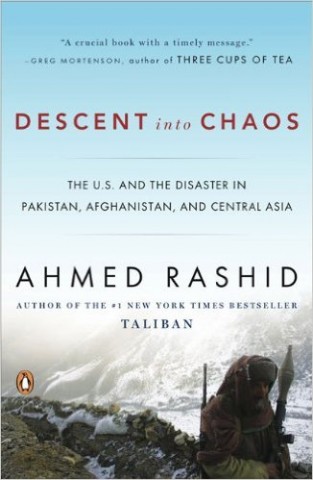Descent into Chaos - Afghanistan
Reflections on international development from Ahmed Rashid's award-winning 2008 book "Descent into Chaos: The U.S. and the Disaster in Pakistan, Afghanistan, and Central Asia." For those interested in the region, or of military intervention in the era of the 'war on terror' this is essential reading.
Proposals before 9/11:
- "We proposed using economic aid related to the reconstruction of Afghanistan as a tool to isolate the Taliban and create an alternative political infrastructure that could also become a lobby for peace inside the country. Similar thoughts were being advocated by other U.S. and European officials." (p. 55)
Priorities and consequences:
- "President Bush's embrace of Musharraf and the military, rather than of the Pakistani people and the development of state institutions and a democratic process, has created an immense hatred for the U.S. Army and America, hatred that penetrates all classes of society. Ninety percent of the $10 billion in aid that the United States has provided Pakistan with since 9/11 has gone to the military rather than to development." (p. xxxix)
- "Richard Clarke attended meetings on Iraq on September 12. He later wrote, "At first I was incredulous that we were talking about something other than getting al Qaeda. Then I realized with almost a sharp physical pain that Rumsfeld and Wolfowitz were going to try and take advantage of this national tragedy to promote their agenda about Iraq." I visited Washington several times in early 2002, sincerely believing that now the United States would do the right thing by Afghanistan and rebuild the country. I came up with suggestions for the State Department and the U.S. Agency for International Development as to how they could speed up nation building. By the early summer of 2002, when it became clear that the United States had no intentions of rebuilding Afghanistan, disillusionment set in as I saw that Iraq was the real target." (p. 64)
On aid in Afghanistan:
- "…in many areas, USAID humanitarian food deliveries and development projects were being taken over by the joint CAI-SOF teams. Credible Afghan tribal leaders who had been identified by the Afghan government or the UN as "positive agents of change," capable of fostering stability at the community level, were bypassed in favor of the commanders and warlords preferred by the CIA. Afghan civil society was being strangled even as it emerged, and the Afghan government was made to look incompetent and powerless. Afghan policy was now in the hands of covert CIA-SOF operatives, who had vast sums at their disposal but no mandate to rebuild the country." (p. 136)
- "Several USAID officials were to resign disillusioned with their organization, disgusted at U.S. policy, and frustrated at their failure to be effective. USAID was eventually to get swept into the State Department and lose what little independence it once had. In keeping with prevailing views in the Republican Party, USAID became a source of funds for Christian fundamentalist NGOs active in the Muslim world – giving them $57 million between 2001 and 2005 out of a total of $390 million distributed to all NGOs." (p. 176)
Failure:
- "U.S. consultancies and construction firms, rather than local NGOs, won the contracts to implement projects. Louis Berger alone won contracts to build ninety-six new clinics and schools in time for the Afghan elections, but a year later, at the end of 2005, only nine clinics and two schools had been completed. Designs for school buildings drawn up in California did not take into account excessive snowfall in Afghanistan, which buckled roofs. Some roofs were designed with so much steel that they could be put in place only with cranes, which were unavailable. A report by the U.S. Government Accountability Office published in 2005 stated that the projects were having little impact on reconstructing the country." (p. 190-191).
- "Farmers were paid cash for eradicating their crop [opium] at the rate of $1,250 to $1,500 per hectare. MI6 and British commandos handed over cash to governors and police chiefs in the provinces to pay off the farmers. The program, which cost more than $80 million, was mired in massive corruption, as Afghan officials distributed the money to their tribes or clans, who took the cash but failed to eradicate the crop. Other farmers used the money to increase cultivation, while thousands of other who did eradicate their crop received nothing. A huge piece of the money ended up in the war chests of the warlords." (p. 321)
Featured Posts
Tags
Agriculture
Democracy
Ethiopia
Middle East
Civil society
Education
Development Studies
Poverty
Rural Development
Africa
South Africa
Ethics
Globalization
Islam
Revolution
Ideology
Conflict
Human Rights
decolonization
Migration
Culture
Politics
Climate change
Land
Interdisciplinary
Sustainability
Capitalism
International development
Qatar
Anthropology
Colonialism
Post-doc
Racism
Books
Development
Food Security
Power
Resilience
Institutions
Leadership
Governance
Colonization
Policy
History
Inequality
Economics
Fellowship
Participation
Gender
Ethnography

